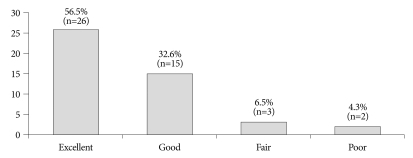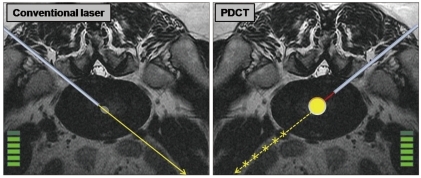J Korean Neurosurg Soc.
2012 Jan;51(1):8-13. 10.3340/jkns.2012.51.1.8.
Clinical Outcomes of Percutaneous Plasma Disc Coagulation Therapy for Lumbar Herniated Disc Diseases
- Affiliations
-
- 1Department of Neurosurgery, Ajou University School of Medicine, Suwon, Korea. shkim709@ajou.ac.kr
- KMID: 2190461
- DOI: http://doi.org/10.3340/jkns.2012.51.1.8
Abstract
OBJECTIVE
This is prospective study of clinical outcomes of percutaneous plasma disc coagulation Therapy (PDCT) in patients with herniated lumbar disc disease (HLD) to evaluate the safety and efficacy in its clinical application and usefulness as a reliable alternative to microscopic discectomy.
METHODS
Forty-six patients were enrolled in this study from April 2006 to June 2010. All patients had one-level HLD. Disc degeneration was graded on routine T2-weighted magnetic resonance Image (MRI) using the Pfirrmann's grading system and all index levels were grade 3 and grade 4. Indications for surgery were radiculopathy caused by disc protrusion with soft consistency. MRI was done at one month after the procedure in all patients to check post-PDCT change. The clinical outcomes were evaluated using Visual Analog Scales (VAS) score and MacNab's criteria.
RESULTS
This study was approved by the Institutional Review Board of our institution. The age of the study population ranged from 16 to 59 years with a mean age of 37.2 years. There were 29 males and 17 females in this study. The mean period of clinical follow-up was 21 months. The average preoperative VAS score for radiculopathy was 7.4+/-1.4, while the final follow-up VAS score was 1.4+/-0.7 (p<0.001). In MacNab's criteria, 41 patients (89.1%) had achieved favorable improvement (excellent and good) until later follow-up. There were one patient from infection and two patients who needed to convert to open discectomy.
CONCLUSION
PDCT is a safe and efficient treatment modality in a selective patient with HLD.
Keyword
MeSH Terms
Figure
Reference
-
1. Bhagia SM, Slipman CW, Nirschl M, Isaac Z, El-Abd O, Sharps LS, et al. Side effects and complications after percutaneous disc decompression using coblation technology. Am J Phys Med Rehabil. 2006; 85:6–13. PMID: 16357543.
Article2. Bonaldi G. Automated percutaneous lumbar discectomy : technique, indications and clinical follow-up in over 1000 patients. Neuroradiology. 2003; 45:735–743. PMID: 13680028.
Article3. Buenaventura RM, Datta S, Abdi S, Smith HS. Systematic review of therapeutic lumbar transforaminal epidural steroid injections. Pain Physician. 2009; 12:233–251. PMID: 19165306.4. Castro WH, Halm H, Jerosch J, Schilgen M, Winkelmann W. [Changes in the lumbar intervertebral disk following use of the Holmium-Yag laser--a biomechanical study]. Z Orthop Ihre Grenzgeb. 1993; 131:610–614. PMID: 8310755.5. Cesaroni A, Nardi PV. Plasma disc decompression for contained cervical disc herniation : a randomized, controlled trial. Eur Spine J. 2010; 19:477–486. PMID: 19902277.
Article6. Chen YC, Lee SH, Chen D. Intradiscal pressure study of percutaneous disc decompression with nucleoplasty in human cadavers. Spine (Phila Pa 1976). 2003; 28:661–665. PMID: 12671352.
Article7. Choi JY, Tanenbaum BS, Milner TE, Dao XV, Nelson JS, Sobol EN, et al. Theramal, mechanical, optical, and morphologic changes in bovine nucleus pulposus induced by Nd:YAG (lambda=132 microm) laser irradiation. Lasers Surg Med. 2001; 28:248–254. PMID: 11295760.
Article8. Choy DS. Percutaneous laser disc decompression (PLDD) : twelve years' experience with 752 procedures in 518 patients. J Clin Laser Med Surg. 1998; 16:325–331. PMID: 10204439.
Article9. Choy DS, Case RB, Fielding W, Hughes J, Liebler W, Ascher P. Percutaneous laser nucleolysis of lumbar disks. N Engl J Med. 1987; 317:771–772. PMID: 3627193.
Article10. Choy DS, Diwan S. In vitro and in vivo fall of intradiscal pressure with laser disc decompression. J Clin Laser Med Surg. 1992; 10:435–437. PMID: 10148211.
Article11. Choy DS, Michelsen J, Getrajdman G, Diwan S. Percutaneous laser disc decompression : an update--Spring 1992. J Clin Laser Med Surg. 1992; 10:177–184. PMID: 10147861.12. Cohen SP, Larkin T, Abdi S, Chang A, Stojanovic M. Risk factors for failure and complications of intradiscal electrothermal therapy : a pilot study. Spine (Phila Pa 1976). 2003; 28:1142–1147. PMID: 12782982.
Article13. German JW, Adamo MA, Hoppenot RG, Blossom JH, Nagle HA. Perioperative results following lumbar discectomy : comparison of minimally invasive discectomy and standard microdiscectomy. Neurosurg Focus. 2008; 25:E20. PMID: 18673050.14. Gerszten PC, Smuck M, Rathmell JP, Simopoulos TT, Bhagia SM, Mocek CK, et al. Plasma disc decompression compared with fluoroscopy-guided transforaminal epidural steroid injections for symptomatic contained lumbar disc herniation : a prospective, randomized, controlled trial. J Neurosurg Spine. 2010; 12:357–371. PMID: 20201654.
Article15. Hopp E, Tsou PM. Postdecompression lumbar instability. Clin Orthop Relat Res. 1988; 227:143–151. PMID: 2962798.
Article16. Jacobs WC, van Tulder M, Arts M, Rubinstein SM, van Middelkoop M, Ostelo R, et al. Surgery versus conservative management of sciatica due to a lumbar herniated disc : a systematic review. Eur Spine J. 2011; 20:513–522. PMID: 20949289.
Article17. Javid MJ, Nordby EJ, Ford LT, Hejna WJ, Whisler WW, Burton C, et al. Safety and efficacy of chymopapain (Chymodiactin) in herniated nucleus pulposus with sciatica. Results of a randomized, double-blind study. JAMA. 1983; 249:2489–2494. PMID: 6341632.
Article18. Kahanovitz N, Viola K, Muculloch J. Limited surgical discectomy and microdiscectomy. A clinical comparison. Spine (Phila Pa 1976). 1989; 14:79–81. PMID: 2913673.19. Lee SJ, Oh SH, Lee KS, Yi HJ, Bak KH, Kim JM. Nucleoplasty as an alternative intradiscal therapy in patients with lumbar disc herniation. J Korean Neurosurg Soc. 2003; 33:388–392.20. Li J, Yan DL, Zhang ZH. Percutaneous cervical nucleoplasty in the treatment of cervical disc herniation. Eur Spine J. 2008; 17:1664–1669. PMID: 18830638.
Article21. Manchikanti L, Derby R, Benyamin RM, Helm S, Hirsch JA. A systematic review of mechanical lumbar disc decompression with nucleoplasty. Pain Physician. 2009; 12:561–572. PMID: 19461823.22. Nordby EJ, Wright PH, Schofield SR. Safety of chemonucleolysis. Adverse effects reported in the United States, 1982-1991. Clin Orthop Relat Res. 1993; 122–134. PMID: 8339472.
Article23. Osti OL, Fraser RD, Vernon-Roberts B. Discitis after discography. The role of prophylactic antibiotics. J Bone Joint Surg Br. 1990; 72:271–274. PMID: 2312567.
Article24. Pfirrmann CW, Metzdorf A, Zanetti M, Hodler J, Boos N. Magnetic resonance classification of lumbar intervertebral disc degeneration. Spine (Phila Pa 1976). 2001; 26:1873–1878. PMID: 11568697.
Article25. Ramirez LF, Thisted R. Using a national health care data base to determine surgical complications in community hospitals : lumbar discectomy as an example. Neurosurgery. 1989; 25:218–225. PMID: 2770986.
Article26. Rosen C, Rothman S, Zigler J, Capen D. Lumbar facet fracture as a possible source of pain after lumbar laminectomy. Spine (Phila Pa 1976). 1991; 16:S234–S238. PMID: 1862418.
Article27. Schenk B, Brouwer PA, van Buchem MA. Experimental basis of percutaneous laser disc decompression (PLDD) : a review of literature. Lasers Med Sci. 2006; 21:245–249. PMID: 16937074.
Article28. Schofferman J, Kine G. Effectiveness of repeated radiofrequency neurotomy for lumbar facet pain. Spine (Phila Pa 1976). 2004; 29:2471–2473. PMID: 15507813.
Article29. Singh V, Derby R. Percutaneous lumbar disc decompression. Pain Physician. 2006; 9:139–146. PMID: 16703975.30. Singh V, Manchikanti L, Benyamin RM, Helm S, Hirsch JA. Percutaneous lumbar laser disc decompression : a systematic review of current evidence. Pain Physician. 2009; 12:573–588. PMID: 19461824.31. Spengler DM. Lumbar discectomy. Results with limited disc excision and selective foraminotomy. Spine (Phila Pa 1976). 1982; 7:604–607. PMID: 7167834.
- Full Text Links
- Actions
-
Cited
- CITED
-
- Close
- Share
- Similar articles
-
- Percutaneous Disc Coagulation Therapy (PDCT) comparing with Automated Percutaneous Lumbar Discectomy (APLD) in Patients of Herniated Lumbar Disc Disease: Preliminary Report
- Loss of Disc Height after Spontaneous Regression of a Herniated Lumbar Disc: A Case Report
- The Spontaneous Resorption of Herniated Lumbar Disc: A case report
- Clinical Results of Percutaneous Endoscopic Discectomy in Herniated Intervertebral disc of Lumbar Spine
- Effects of Decompression Therapy for the Treatment of a Herniated Lumbar Disc






